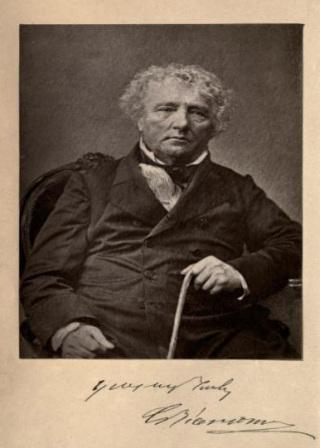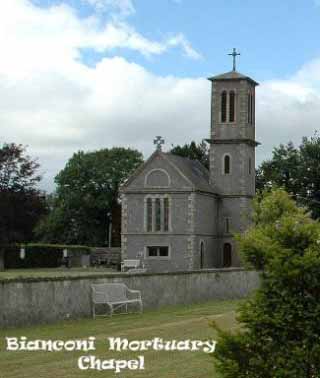 Carlo (Charles) Bianconi was born in Tregolo, in the Lombard Highlands, near Como, Italy on September 24th. 1786. A wild youth and showing no real talent at school, his father paid for him to be sent on an eighteen month apprenticeship to art dealer Andrea Faroni. Faroni with Bianconi and three other apprentice boys in tow, Giuseppe Castelli, Girolamo Camagni and his friend Giuseppe Ribaldi crossed the French Alps and France on foot in 1801, eventually arriving in Dublin in 1802.
Carlo (Charles) Bianconi was born in Tregolo, in the Lombard Highlands, near Como, Italy on September 24th. 1786. A wild youth and showing no real talent at school, his father paid for him to be sent on an eighteen month apprenticeship to art dealer Andrea Faroni. Faroni with Bianconi and three other apprentice boys in tow, Giuseppe Castelli, Girolamo Camagni and his friend Giuseppe Ribaldi crossed the French Alps and France on foot in 1801, eventually arriving in Dublin in 1802.
They set up shop near Essex Street Bridge in the now Temple Bar area of Dublin and the young Bianconi continued to serve his apprenticeship as a street picture-seller equipped with just one word of the English language, the word “buy“. The price of his wares he demonstrated by holding up his fingers to prospective clients, one finger represented one penny.
Later the same year he was sent, weekly, with four pence to cover his expenses, down into rural Ireland. Leaving Dublin on a Monday morning with his pictures he travelled on foot through Munster and Leinster selling his wares and organising his route, thus ensuring to be back in Dublin, to his employer, by late Saturday night. From actual records, we know he was arrested in Passage East, Co Waterford and held in jail, over night, for selling pictures of, the then British number one enemy, Napoleon Bonaparte.
In 1804, on the termination of his eighteen month apprenticeship, he decided not to return home but took to the road selling pictures and frames for himself, carrying his wares in a large box, strapped to his shoulders. The box according to Bianconi himself weighed approximately thirty pounds in weight.
He set up his own shop two years later in Carrick in 1806, but later transferred this business to Waterford and later still to Clonmel Co. Tipperary, where in 1809 he opened at No.1 Gladstone Street as a first class “Carver and Guilder”.
He was a frequent visitor to the Ursuline Convent in Thurles where he admits to being well fed by Reverend Mother Tobin.It was during his travels he met the first love of his life and with the permission of her father sent her to be educated in the Ursuline Convent, Thurles. This love however was never to fully blossom, as his student fell in love with another and Bianconi sadly was forced to give up all pretensions to ever making her his wife.
It is said that ‘necessity is the mother of invention‘ and surely Bianconi is evidence of this fact. Travelling on foot around Ireland, carrying his heavy materials, and often walking twenty to thirty miles each day in the course of this work, quickly demonstrated to Bianconi the great need for a cheap and reliable integrated transport system. It therefore came as no surprise that in July 6th 1815 the first Bianconi two-wheel horse drawn cart, carrying three or four passengers went into commission from Clonmel to Cahir, thus introducing the beginnings of the first ever integrated transport system, into Ireland.
 Travel on one of these “Bians” as they were to become known, cost one-penny farthing a mile. Such demand was there for his transport that over the next 30 years a huge network of communications were established, with Clonmel, Co. Tipperary as its hub. Huge employment was also now created from this growing transport business. The year 1833 saw the “long car” go into production from his coach building premises in Clonmel which enabled him to carry up to twenty passengers, plus cargo and mail deliveries for both British and Irish Post Offices. Here in Thurles, his depot was situated in O`Shea`s Hotel which today trades as McLoughneys, a ladies clothing boutique. The stables where he fed and changed his horses between journeys still exists, relatively unchanged, to this very day and are situated at the rear of Ryan’s Jewellers shop, Liberty Square, Thurles, Co. Tipperary.
Travel on one of these “Bians” as they were to become known, cost one-penny farthing a mile. Such demand was there for his transport that over the next 30 years a huge network of communications were established, with Clonmel, Co. Tipperary as its hub. Huge employment was also now created from this growing transport business. The year 1833 saw the “long car” go into production from his coach building premises in Clonmel which enabled him to carry up to twenty passengers, plus cargo and mail deliveries for both British and Irish Post Offices. Here in Thurles, his depot was situated in O`Shea`s Hotel which today trades as McLoughneys, a ladies clothing boutique. The stables where he fed and changed his horses between journeys still exists, relatively unchanged, to this very day and are situated at the rear of Ryan’s Jewellers shop, Liberty Square, Thurles, Co. Tipperary.
In 1832 Charles Bianconi married Eliza Hayes the daughter of a wealthy Dublin stockbroker. They begot one son, Charles and two daughters Kate and Mary Anne. Kate died in 1854 and her brother Charles ten years later in 1864. The other surviving daughter Mary married Morgan John O`Connell. In 1864 Morgan O’Connell, nephew of Daniel O`Connell (The Liberator), had succeeded to his mother’s property in Clare known as the McMahon Estate. On February 21st. 1865 he married Mary Anne Bianconi, then aged twenty five (died 1908). Mary Anne, in her own right, was the authoress and compiler of several books including the life story of her father (Charles Bianconi, A Biography). Her new husband Morgan was a regular companion of William M.Thackeray, both, indeed, were members of the “Old Fielding’s Club” as was Charles Dickens.
The advent of railway in 1834 brought home to Bianconi the realisation that his coaching business had now only a limited future. He immediately began to buy shares in the different rail lines as they were being built. He began to sell his coaches and long carts to his employees who had worked for him. He, himself, became a director in Daniel O`Connell`s newly founded National Bank and between 1843 and 1846, he became a Councillor and was twice elected Mayor of Clonmel, Co. Tipperary.
It was at this time, also, he purchased the one thousand acre property known then and now as Longfield House, in the parish of Boherlahan, Cashel, Co. Tipperary, where he resided for twenty nine years and died in 1875 aged 89, a millionaire. He is buried in the family mortuary chapel in Boherlahan, Cashel, which he designed and partially constructed himself.
Legend states that as he breathed his last breath a phantom coach and horses were heard coming up the drive of his much loved Longfield House.

I belive I have in the past read that Charles Bianconi used the slogan Faugh-a-Ballagh
“Clear the Way”. Is this correct. I’m aware that the words are from an old Irish war cry. A particular type of car used by Bianconi were called “Faugh-a-Ballaghs”
Bianconi had several classes of horse drawn cart. The light two wheeler faster vehicles were known as “faugh-a-ballaghs,” meaning “clear the way”, a phrase possibly shouted by their drivers anxious to prevent pedestrians being run over in narrow streets. There were the Massey-Dawsons which were next in size and carried 5 persons back to back. The heavy goods cart was known as a Finn Mc’Cool. Latter was a 4 wheels vehicle carrying 10 people on each side, back to back. with a well in the centre for transporting goods and pulled by 2 or 4 horses depending on cargo weight. Collectively all carts were known as ‘Bians’
I have heard of Fishbourne and Bianconi Dublin office and know that Fishbourne operated mainly from Carlow. Does anybody know the history of this Fishbourne firm run by Joseph Fishbourne, or where I could find this information?
Anyone out there with any information on this firm? Your help please.
Fishbourne’s lived at 24 Duke St and were agents to the Great Southern and Western Railway.
Joseph Fishbourne, resided at 26 Bachelor’s walk, 16 Duke St and 33 Lower Gardiner St .
According to the Dublin Street Directory, of 1862 a yard and stables at 14 to 22 Park Gate Street were owned by Joseph Fishbourne.
If you are still interested in the Fishbournes, I have lots of information about this family and am currently writing a book about them. Please get in touch with me.
Kaye Cole
Love the Bianconi stories. My greatgrandfather Thomas McGrath worked as a coachman in Longfield house. He lived in the lodge on the front avenue and all his family were born there. My grandmother, his daughter Bridget, went into service in the big house and trained to be a cook, where she continued to work until her retirement. There she met my grandfather Pake Maher who was a gardener there. They married and moved into what was called The “Cottage” at the back of the main house, where their two children; my mother Kitty and uncle Tom were born. All worked for Molly Watson who was Bianconi’s granddaughter. Longfield House was run as a hotel all this time. My mother married and continued to live there, where I was born in the same house. The hotel closed and they all moved out in 1952. My mother loved telling that she often slept in Bianconi’s bed, a big four poster. This year I plan to visit where Bianconi was born in Italy. I have lovely photos of these times at the house and gardens.
Thank you for your comment. What a wonderful story and thank you for sharing it with us. Enjoy your upcoming trip and if you would like to share some of your old pictures we would love to view them.
I wonder does Anne Collins Egan have any information on Arabella Bianconi (nee Burke Hayes and a sister of my grandmother Emily Burke Hayes Craig)? Arabella, known as Bella, was the mother of Molly Bianconi Watson author of the biography of Bianconi founder of the Bians. She lived at Longfield House after her separation from John O’Connell Bianconi but died I think in Dublin.
I have no concrete story other than stories from my mother. Molly, I knew and remember well. I have photos of Molly sadly but none of her mother. How amazing G to speak to one of her relations.
Actually Molly was the great granddaughter of Bianconi. Pity you have no stories about Molly’s mother.
Does anyone knows what Charles’ heirs are up to nowadays?